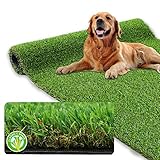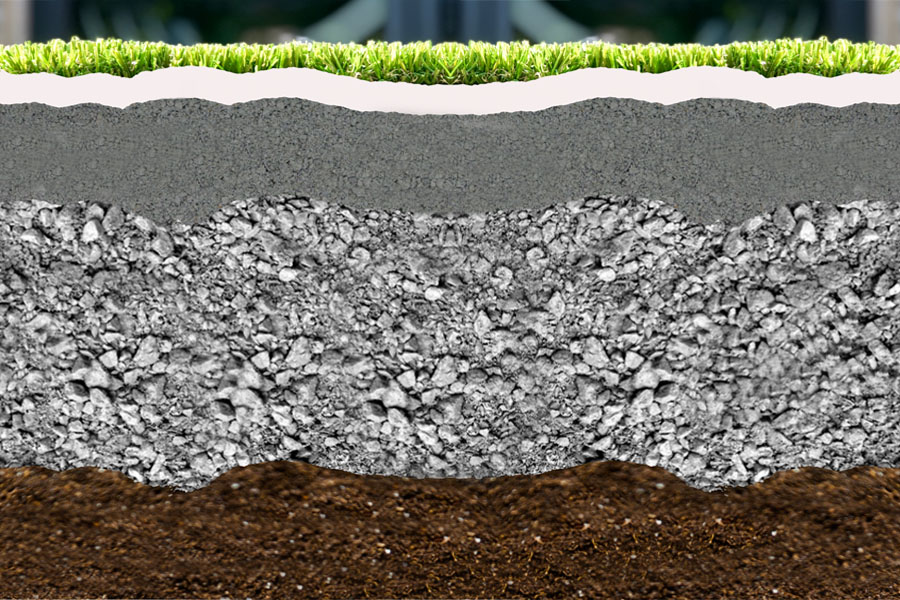Our guide to preparing the ground with the best sub-base for artificial grass.
The layer underneath your artificial grass is what’s known as the sub-base.
It’s mostly a sand-gravel mix but in some circumstances may require asphalt, concrete or wood depending on your application and conditions.
Fitting your yard or garden out with artificial grass is a simple process that yields rewards for many years to come. But by failing to use the best artificial grass sub-base during installation, you can find yourself having achieved a less than desirable final result.
The right artificial grass sub-base is very important in the installation and fitting of your turf because it ensures that a solid and drainable foundation is provided.
This guide will help you get ready and ultimately choose the best sub-base for your artificial grass project.
Table of Contents
Ground Preparation for Artificial Grass

Placing artificial grass directly on the ground without any sort of sub-base is not recommended.
This is because of the effects of expansion and contraction, often leading to wrinkles and pits forming on the lawn.
The best sub-base for artificial grass replaces the traditional ground surface with a stable and non-expansive layer; thereby ultimately giving your turf a durable, drainable sub-base that will last for years to come.
Types of Sub-Bases
There are three main sub-bases that you can use when laying artificial grass in your garden, backyard, pool area or balcony.
Crushed Miscellaneous Base (CMB)

This sub-base is best used as an underlay for artificial grass where natural turf, paving or concrete was originally present.
CMB is an aggregate made up of gravel, sand, asphalt and cement that is typically used for landscaping purposes. As a result, it can be effectively used as a sub-base for artificial grass.
CMB is best used as a sub-base in areas that do not need to be leveled, or areas that require a build-up of 25-50mm. It compacts well, giving a solid foundation for artificial grass and has the added advantage of being one of the more affordable sub-bases on the market.
Class II Road Base

This is arguably the most reliable and most expensive sub-base used for artificial grass and is mostly used for large or industrial scale installations.
Class II road base is built with scientifically advanced materials and most often used under commercial and sport field artificial grass. Applications include under football pitches or synthetic greens on golf courses.
As one of the more expensive types of sub-base, it is rarely used for domestic purposes in the installation of artificial grass.
Decomposed Granite/Limestone Chippings

We would consider this solution as the best overall sub-base for your residential artificial grass project. This comes down to the fact that the nature of granite and limestone is optimally porous, which makes for good drainage underneath your turf.
Decomposed granite sub-bases are made up of fragments that weather and fall away from the main rock body. Ultimately, these fragments help in making it porous and are the most effective sub-base for artificial grass.
Decomposed granite is smoother than CMB and because it can offer excellent drainage, decomposed granite is an excellent long term solution for your home.
These sub-bases offer the best layering for your artificial grass, albeit at a relatively higher cost.
How Much Sub-Base is Required?
To have a sub-base with a firm foundation, void of pits and holes on the artificial grass, we must ensure that the right depth of sub-base is used.
Keep in mind that sub-base depth may vary on different surfaces.
- Soil: A sub-base built on soil or dirt requires a depth of about 50-100mm, depending on the application. For domestic purposes, a depth of 50mm on soil is often enough.
Concrete: When building a sub-base over concrete, a depth of 50mm will usually suffice in firmly holding your artificial grass. - Rooftops: When we say rooftops, we are referring to shared rooftops on apartment buildings and the like. For safety, we recommend that for the installation of a sub-base on any rooftop surface, you bring in a professional.
- Wooden Decking: For a wooden deck, the sub-base should be tough enough to carry the required weight above.
Installing the Base for Artificial Grass

In order to install a sub-base for artificial grass on any surface, you first need to prepare the area.
Here is a handy checklist for you to follow before installing sub-base on a natural soil surface:
- Check for underground hazards
- Get rid of weeds
- Remove a layer of topsoil
- Plan your drainage
- Install a bender board to clearly map out the territory
- Install a weed barrier
The process of installing the sub-base for artificial grass on other surfaces like balconies, decks, or patios is very similar with only a few differences.
You’re now ready to install your artificial grass.








